大学英语泛读教程2PPT教学课件-Unit 3
- 格式:ppt
- 大小:6.45 MB
- 文档页数:33
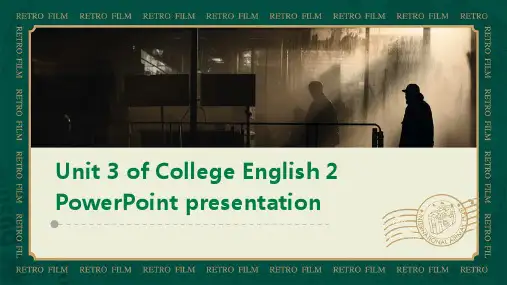
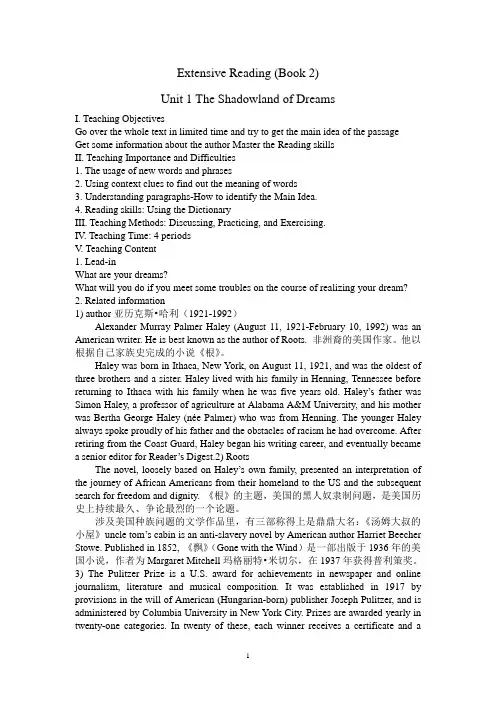
Extensive Reading (Book 2)Unit 1 The Shadowland of DreamsI. Teaching ObjectivesGo over the whole text in limited time and try to get the main idea of the passageGet some information about the author Master the Reading skillsII. Teaching Importance and Difficulties1. The usage of new words and phrases2. Using context clues to find out the meaning of words3. Understanding paragraphs-How to identify the Main Idea.4. Reading skills: Using the DictionaryIII. Teaching Methods: Discussing, Practicing, and Exercising.IV. Teaching Time: 4 periodsV. Teaching Content1. Lead-inWhat are your dreams?What will you do if you meet some troubles on the course of realizing your dream? 2. Related information1) author亚历克斯•哈利(1921-1992)Alexander Murray Palmer Haley (August 11, 1921-February 10, 1992) was an American writer. He is best known as the author of Roots. 非洲裔的美国作家。
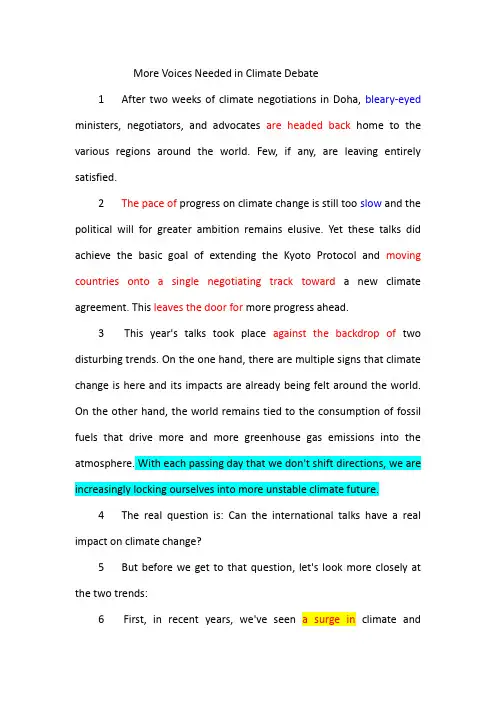
More Voices Needed in Climate Debate1 After two weeks of climate negotiations in Doha, bleary-eyed ministers, negotiators, and advocates are headed back home to the various regions around the world. Few, if any, are leaving entirely satisfied.2 The pace of progress on climate change is still too slow and the political will for greater ambition remains elusive. Yet these talks did achieve the basic goal of extending the Kyoto Protocol and moving countries onto a single negotiating track toward a new climate agreement. This leaves the door for more progress ahead.3 This year's talks took place against the backdrop of two disturbing trends. On the one hand, there are multiple signs that climate change is here and its impacts are already being felt around the world. On the other hand, the world remains tied to the consumption of fossil fuels that drive more and more greenhouse gas emissions into the atmosphere. With each passing day that we don't shift directions, we are increasingly locking ourselves into more unstable climate future.4 The real question is: Can the international talks have a real impact on climate change?5 But before we get to that question, let's look more closely at the two trends:6 First, in recent years, we've seen a surge in climate andextreme weather events, along with analysis and other evidence that the world is on an unsustainable course. The most recent and tragic example was Super Typhoon Bopha that swept across the Philippines this week, killing at least 500 people and leaving tens of thousands displaced. Typhoons aren't unusual in the Philippines, but this one is the most southern on record and it arrived particularly late in the year. The storm, of course,comes on the heels of Hurricane Sandy, which swept through the Caribbean and up the East Coast of the United States, leaving hundreds dead, and thousands without power or property. These are the kind of extreme weather events that are becoming more common in a warming world. Last month, the US government has just reported, was the 332nd in succession in which the global temperature was above the average for the 20th century: though individual areas have sometimes suffered cold spells, the last below-average month worldwide was February 1985. And the effects are increasingly showing. Already we are seeing that polar ice is melting faster than expected and sea levels are rising beyond many projections. For instance, NOAA (US National Oceanic and Atmospheric Administration) just released a study showing that sea levels could rise as much as 6.6 feet by the end of the century.7 The World Bank's report, "Turning Down the Heat," explores a world with four degrees Celsius of global temperature growth. The picture is not pretty. Four degrees would bring more intense wildfires,heat waves, and withering droughts. Ocean life would die off, while pests and disease would increase, the report says. The European Environment Agency this week published a 300-page report detailing the impact of global warming on the continent, from crops to coasts, floods to forests —and earlier this year the giant Climate Vulnerability Monitor report concluded that it was already costing about 1 per cent of global GDP and, together with the carbon-based economy, causing five million deaths a year, mainly in poor countries.8 That brings us to the second major trend, which is the world's ongoing dependence on fossil fuels. WRI (World Resources Institute) recently released an analysis showing that there are nearly 1,200 new proposed coal plants worldwide. While not all of these will be developed, even a fraction of them would drive up global emissions. Oil, likewise, remains a dominant fuel source. And, despite the enormous profits, the International Energy Agency has reported that government subsidies for fossil fuels were six times those for renewable energy in 2011. This dependence on fossil fuels keeps pushing up the global emissions. Total annual greenhouse gas emissions have increased by about a third over the past decade, and carbon dioxide concentrations in the atmosphere are now higher than at any time in the past 15 million years.9 That's why what happens in the global climate agreements is so crucial. The UN is the only venue that brings all countries togetherand gives each a chance to have a voice. It provides a common arena that enhances transparency and accountability among countries. Of course, the international system cannot solve the problem on its own. We need business leaders, government officials, and the public to step up as well. We need more of their voices in the debate. Fortunately, public understanding of climate change is on the rise, as is support for action. Greater domestic action can instill confidence and help build momentum. With more national leadership, the UN can move faster and take a bigger bite out of global emissions.10 Turning again to the Doha meeting, it's certainly clear that the meeting alone won't do enough to address this issue. But it does put countries on a track and provides them with the opportunity to raise their ambition.11 The big task, therefore, is to make progress on a commitment made at the last climate summit, in Durban in 2011, to reach a new agreement "with legal force" by 2015, binding all countries to control emissions. This, in itself, was a breakthrough, and there are some reasons for cautious optimism that progress will continue.12 Many of the obstacles to progress in the past are diminishing. The United States —through regulation and using shale gas —is likely to hit its target fo r reducing emissions by 17 percent by 2020, and President Obama has started to talk about acting on climate change, forthe first time in years, after his election and Super-storm Sandy. Saudi Arabia, long the strongest opponent of change, is now investing heavily in solar power. China is starting its own emissions trading scheme to control carbon releases, and its new leadership is expected to give a higher priority to the environment.13 It's time for world leaders, negotiators and the public to increase their intensity, to develop more specific strategies, and deliver more emission reductions. We need to build on Doha and get on a path to a strong, fair and ambitious climate agreement.。



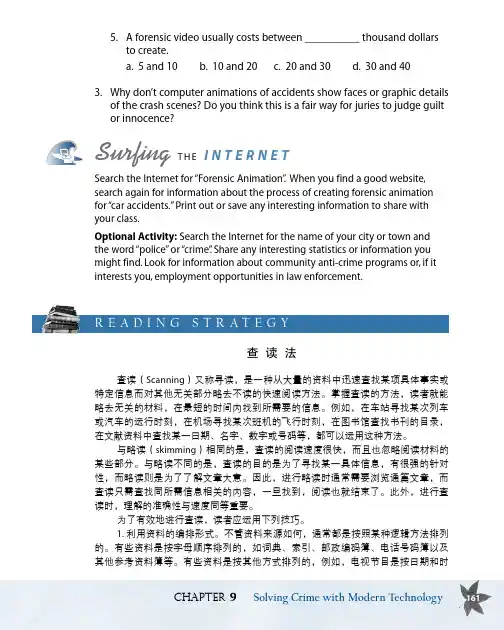
5. A forensic video usually costs between __________ thousand dollarsto create.a. 5 and 10b. 10 and 20c. 20 and 30d. 30 and 403. Why don’t computer animations of accidents show faces or graphic detailsof the crash scenes? Do you think this is a fair way for juries to judge guiltor innocence?Surfing T H E I n T e r n e TSearch the Internet for “Forensic Animation”. When you find a good website,search again for information about the process of creating forensic animationfor “car accidents.” Print out or save any interesting information to share withyour class.Optional Activity: Search the Internet for the name of your city or town andthe word “police” or “crime”. Share any interesting statistics or information youmight find. Look for information about community anti-crime programs or, if it interests you, employment opportunities in law enforcement.r E A D I N g S T r A T E g y查 读 法查读(Scanning)又称寻读,是一种从大量的资料中迅速查找某项具体事实或特定信息而对其他无关部分略去不读的快速阅读方法。
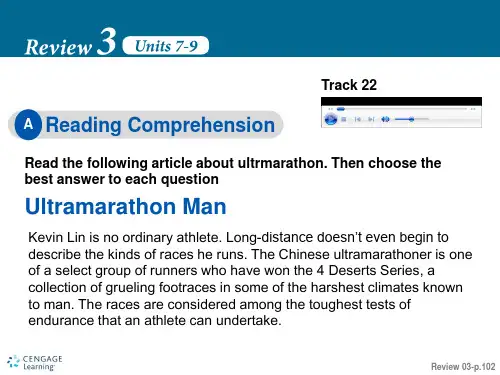
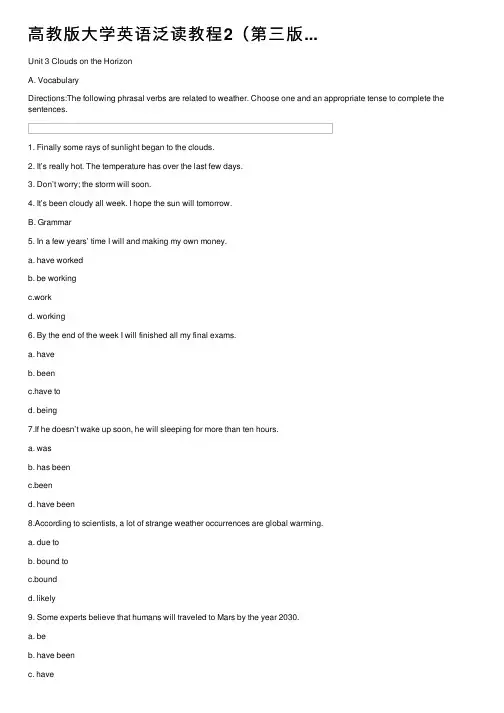
⾼教版⼤学英语泛读教程2(第三版...Unit 3 Clouds on the HorizonA. VocabularyDirections:The following phrasal verbs are related to weather. Choose one and an appropriate tense to complete the sentences.1. Finally some rays of sunlight began to the clouds.2. It’s really hot. The temperature has over the last few days.3. Don’t worry; the storm will soon.4. It’s been cloudy all week. I hope the sun will tomorrow.B. Grammar5. In a few years’ time I will and making my own money.a. have workedb. be workingc.workd. working6. By the end of the week I will finished all my final exams.a. haveb. beenc.have tod. being7.If he doesn’t wake up soon, he will sleeping for more than ten hours.a. wasb. has beenc.beend. have been8.According to scientists, a lot of strange weather occurrences are global warming.a. due tob. bound toc.boundd. likely9. Some experts believe that humans will traveled to Mars by the year 2030.a. beb. have beenc. haved. have toC. Reading ComprehensionDirections: Read the excerpt and answer the questions 1 to 3 below.10.What would be the best heading for this excerpt?a. How to Observe English Weatherb. Famous English Quotesc. English Icebreakerd. Chatting in Different Countries11.What does the writer mean in the underlined phrase above?a. English people love art.b. English people can always chat about the weather.c. English people are too shy.d. English people are very observant with friends.12.The word draw is closest in meaning to which of the following?a. causeb. sketchc. remarkd. commentDirections: Read the excerpt from Climate Change: Facing the Future in Unit 3. The four paragraphs in the body of the text refer to possible effects of climate change.Which paragraph includes:13. a figure expressed in degrees Celsius?14. a question for the reader?15. a disagreement on an effect of global warming?16. a title for weather scientists?17. the possibility of natural disasters?18. An organization that involves more than one country?Directions: Read the excerpts from Climate Change in the Further Reading section of Unit 3. Choose the best answer for the questions that follow.19. Which of the following explanations best describes the “vicious circle” mentioned by theauthor?a. No topsoil means no plants, and no plants means no topsoil.b. Vegetation is destroyed by rain and rain is prevented by vegetation.c. Moisture damages irrigation and irrigation reduces moisture.d. Climate change creates more trees, and trees increase climate change.20. What does the author imply about Canada?a. It’s not generally thought of as humid.b. It’s not a place people talk about a lot.c. It’s home to variety of languages.d. It’s a safe place to bet.。
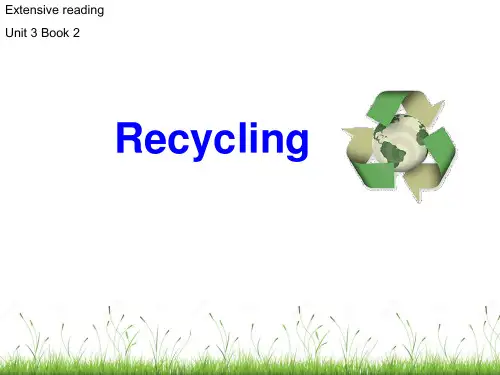

Extensive Reading (Book 2)Unit 1 The Shadowland of Dreams1. Ieaching ObjeclivesGio over the whole lext in limiled lime and lry Lo gel the main idta of lhe passage(iel som1 information aboul lhe author Masler lhe Keading skillsII. Teaching Importance ad Diticulies1. The usage of new words and plrases2. Using context clues to find out the meaning of words3. UInderstanding paragraphs-How to identifty thc Main ldca.4. Rading sills: Using the DictionaryII. Teasching Melhods: Discussing, Practicing, and F:xcrcising.IV. Teaching Time: 4 periodsV Teaching Conltenl1. Lead-inWhat are your drcams?What will you do if you meet some troubles on the course of realizing your dream?2. Related information1) anuthor亚历克斯哈利(1921-1992)Alexander Muray Pulmer Ilaley (August 11, 1921-Tebruary 10. 1992) was anAmerican wriler. Ile is best known as the author of Rools.非洲商的美国作家。